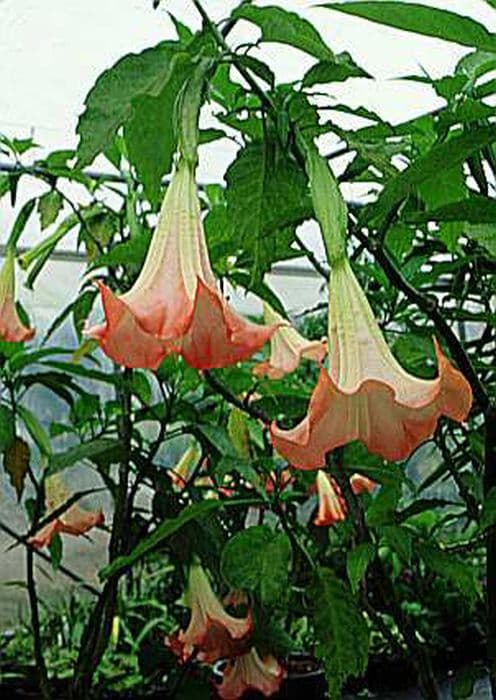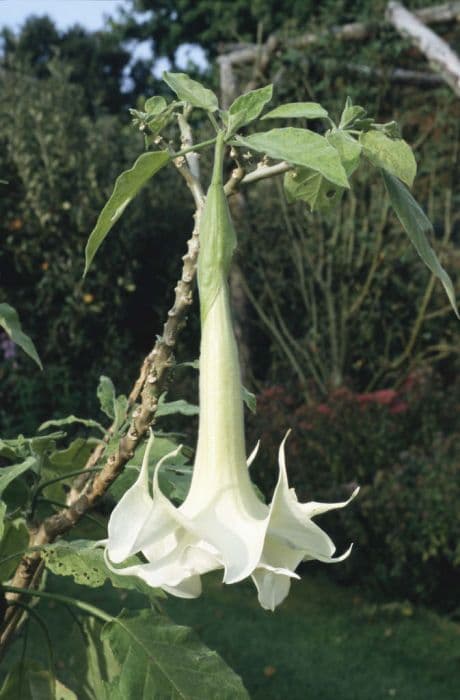Butterfly flower Schizanthus grahamii

ABOUT
The plant widely known as Graham's Butterfly Flower showcases a captivating array of delicate blooms that boast a remarkable resemblance to butterflies. This enchanting quality is achieved through the petals' intricate patterning, which often showcases a combination of vibrant hues such as pink, purple, red, or orange, with accents of yellow or white that enhance the floral display's visual allure. Each individual flower is a work of art, with its unique bilateral symmetry and an overall shape that mimics the form of a butterfly complete with spread wings. The floral structure typically features an upper pair of lobes and a lower trio, creating a distinctive and memorable silhouette against the plant's backdrop. Beyond its mesmerizing flowers, the plant also presents ornate foliage that complements the floral show. The leaves are finely divided and feathery in appearance, contributing to the overall delicate and lacey texture of the plant. They provide a lush green canvas that accentuates the colorful profusion of the butterfly-like blooms. Despite its ethereal appearance, the Butterfly Flower is not just a feast for the eyes; it is also known to attract a variety of pollinators, adding a lively buzz to its visual splendor. Its propensity to bring in such guests further emphasizes its role as a magnet for local wildlife and enhances the dynamic nature of any garden space it graces.
About this plant
 Names
NamesFamily
Solanaceae
Synonyms
Graham's Butterfly Flower, Poor Man's Orchid, Butterfly Flower
Common names
Schizanthus grahamii
 Toxicity
ToxicityTo humans
Schizanthus grahamii, commonly known as Poor Man's Orchid, is not known to be toxic to humans. There are no significant reports or notable symptoms associated with the poisoning of humans by this plant. Consequently, ingesting any part of Poor Man's Orchid is not expected to have harmful effects.
To pets
Schizanthus grahamii, commonly known as Poor Man's Orchid, is also not known to be toxic to pets such as dogs and cats. There are no well-documented cases of pet poisoning from ingesting any part of this plant, and it's not listed as toxic in common pet poison resources. Therefore, consumption of Poor Man's Orchid by pets is not expected to result in any significant harmful consequences.
 Characteristics
CharacteristicsLife cycle
Annuals
Foliage type
Deciduous
Color of leaves
Green
Flower color
Varies
Height
1-2 feet (30-60 cm)
Spread
1 foot (30 cm)
Plant type
Herb
Hardiness zones
10
Native area
Chile
Benefits
 General Benefits
General Benefits- Ornamental Value: Schizanthus grahamii, known as Poor Man's Orchid, has striking flowers that resemble orchids, which make it an attractive addition to gardens and homes for aesthetic purposes.
- Ease of Care: It is relatively easy to grow and maintain, making it suitable for amateur gardeners or those new to gardening.
- Seasonal Interest: The plant blooms abundantly in spring and summer, providing seasonal visual interest to gardens and landscapes.
- Pollinator Friendly: The vibrant flowers attract bees, butterflies, and other beneficial pollinators, supporting local ecosystems.
- Versatility in Use: Poor Man's Orchid can be used in a variety of garden settings, such as borders, containers, and as a bedding plant, offering flexibility in garden design.
- Edible Parts: In certain cultures, the plant may be used for its edible parts, though it is not commonly recognized as a food source.
- Fast Growth: It has a quick growth cycle, allowing gardeners to enjoy its decorative qualities shortly after planting.
 Medical Properties
Medical PropertiesThis plant is not used for medical purposes.
 Air-purifying Qualities
Air-purifying QualitiesThis plant is not specifically known for air purifying qualities.
 Other Uses
Other Uses- Schizanthus grahamii, commonly known as Poor Man's Orchid, can be used in educational settings such as schools and botanical gardens to teach students about plant biology and hybridization due to its unique floral structure.
- The vibrant flowers of Poor Man's Orchid make it an excellent choice for arts and crafts, providing natural, biodegradable material for eco-friendly projects.
- In theme gardens, the distinctive look of Poor Man's Orchid can be employed to create a whimsical or fairy-tale ambiance, especially when planting in mass in a woodland setting.
- Poor Man's Orchid can be used as subject matter in photography, capturing the intricate details and colors of the flowers for use in art or for photo contests emphasizing natural beauty.
- With its visually striking appearance, Poor Man's Orchid can be used in fashion design as inspiration for prints, patterns, and textures in textiles.
- This plant can be part of a sensory garden, with its range of colors and delicate textures providing a unique sensory experience.
- Poor Man's Orchid's flowers can be pressed and preserved in clear resin to make natural jewelry items like pendants and earrings.
- In culinary presentations, although not typically edible or used in cooking, the petals of Poor Man's Orchid can adorn plates or cake decorations for special events (ensure petals are free from pesticides).
- For hobbyists who practice the art of ikebana, a Japanese flower arranging technique, Poor Man's Orchid provides an exotic and colorful addition to their compositions.
- Dried flowers of Schizanthus grahamii can be used in potpourri mixtures to add color and a light floral scent to a room when mixed with other dried flowers and spices.
Interesting Facts
 Feng Shui
Feng ShuiThe Butterfly Flower is not used in Feng Shui practice.
 Zodiac Sign Compitability
Zodiac Sign CompitabilityThe Butterfly Flower is not used in astrology practice.
 Plant Symbolism
Plant Symbolism- Intricacy: Schizanthus grahamii, commonly known as Poor Man's Orchid, boasts complex and detailed flowers, symbolizing the beauty and intricacy of life's finer details.
- Ephemerality: With its short-lived blossoms, the Poor Man's Orchid reflects the transient nature of existence, encouraging one to cherish every moment.
- Resourcefulness: As the plant can thrive in a range of conditions, it symbolizes adaptability and making the most out of one's environment.
- Surprise and Delight: The unexpected beauty of the Poor Man's Orchid, which at first glance appears as a delicate orchid, represents the joy of discovering unexpected beauty in humble places.
 Water
WaterPoor Man's Orchid (Schizanthus grahamii) prefers consistently moist soil, so water it thoroughly when the top inch of soil feels dry to the touch. This may translate to watering approximately once a week, but frequency can vary depending on environmental conditions. Use about a quart of water for a medium-sized pot, ensuring that excess water can drain to avoid waterlogging. During the growing season, they may need more frequent watering, whereas in the winter, water less often as the plant growth slows down.
 Light
LightPoor Man's Orchid thrives in bright, indirect sunlight. It’s best positioned in a spot where it can receive plenty of light without being exposed to harsh, direct afternoon sun, which could scorch the delicate leaves and flowers. A north or east-facing window is typically ideal for this plant.
 Temperature
TemperaturePoor Man's Orchid prefers temperatures between 50 to 75 degrees Fahrenheit. Keep the plant away from drafts and sudden temperature changes which can stress it. It can tolerate a minimum temperature of 40 degrees Fahrenheit for brief periods, but frost or freezing conditions should be strictly avoided.
 Pruning
PruningPoor Man's Orchid can benefit from pruning to remove faded flowers and encourage further blooming. Prune the spent blooms and any yellowing leaves periodically throughout the flowering season. The best time for more extensive pruning is after the main flowering period has finished, usually in late summer or early fall.
 Cleaning
CleaningAs needed
 Soil
SoilPoor Man's Orchid thrives in well-draining soil with good organic matter content. A mix of peat, perlite, and loam with a pH of 6.0-7.0 suits it well for optimal growth and flowering.
 Repotting
RepottingPoor Man's Orchid should be repotted annually in the spring to replenish its soil and accommodate root growth, ensuring a fresh, nutrient-rich environment.
 Humidity & Misting
Humidity & MistingPoor Man's Orchid prefers moderate to high humidity levels, generally around 50-70%, to mimic its native habitat conditions and support its growth.
 Suitable locations
Suitable locationsIndoor
Provide bright indirect light and keep the soil moist for Poor Man's Orchid.
Outdoor
Place in partial shade and protect from strong winds for Poor Man's Orchid.
Hardiness zone
9-11 USDA
 Life cycle
Life cycleSchizanthus grahamii, also known as Graham's butterfly flower or poor man's orchid, starts its life cycle as a seed, commonly sown in spring. Upon germination, the seedlings develop into small rosettes of foliage, where true leaves can be distinguished from the cotyledons. As the plant matures, it enters a vegetative stage, characterized by the growth of the stem and the proliferation of intricate, fern-like leaves. The flowering stage follows, usually in the late spring or early summer, where the plant produces a profusion of orchid-like flowers with vibrant colors and markings that attract pollinators. After pollination, the flowers develop into capsules that contain numerous tiny seeds. The plant completes its life cycle when it dies back after seeding, typically behaving as an annual or biennial depending on the growing conditions.
 Propogation
PropogationPropogation time
Spring to Summer
The most popular method for propagating Schizanthus grahamii, commonly known as Poor Man's Orchid, is through seed. Seed propagation is generally done in the spring, when the danger of frost has passed. To propagate, scatter the seeds lightly on the surface of a well-draining seed starting mix and press them gently into the soil. Poor Man's Orchid seeds need light to germinate, so they should not be covered with soil. Keep the substrate moist but not saturated and maintain a temperature between 60 to 70 degrees Fahrenheit (15 to 21 degrees Celsius). Germination usually occurs within 10 to 20 days. Once seedlings are large enough to handle, they can be transplanted into individual pots or directly into the garden if outdoor conditions are suitable.


![Calibrachoa [Aloha Classic Blue Sky]](/_next/image?url=https%3A%2F%2Fplants-admin.emdemapps.com%2Fimages%2Fplants%2F%2Fimages%2F604b636c3778b.png&w=640&q=75)
![Calibrachoa [Aloha Classic Gold]](/_next/image?url=https%3A%2F%2Fplants-admin.emdemapps.com%2Fimages%2Fplants%2F%2Fimages%2F604b6284c573e.png&w=640&q=75)
![Calibrachoa [Aloha Classic Tiki Soft Pink]](/_next/image?url=https%3A%2F%2Fplants-admin.emdemapps.com%2Fimages%2Fplants%2F%2Fimages%2F604b548e0a5ef.png&w=640&q=75)
![Calibrachoa [Cabaret Deep Yellow]](/_next/image?url=https%3A%2F%2Fplants-admin.emdemapps.com%2Fimages%2Fplants%2F%2Fimages%2F604b5f20ca3ef.png&w=640&q=75)
![Calibrachoa [Calibasket Radiant Orange]](/_next/image?url=https%3A%2F%2Fplants-admin.emdemapps.com%2Fimages%2Fplants%2F%2Fimages%2F604b536d43cb2.png&w=640&q=75)
![Calibrachoa [Caloha Classic Blue Velvet]](/_next/image?url=https%3A%2F%2Fplants-admin.emdemapps.com%2Fimages%2Fplants%2F%2Fimages%2F604b604884a75.png&w=640&q=75)
![Calibrachoa [Caloha Classic Honey White]](/_next/image?url=https%3A%2F%2Fplants-admin.emdemapps.com%2Fimages%2Fplants%2F%2Fimages%2F604b5f56e0beb.png&w=640&q=75)
![Calibrachoa [Caloha Classic Yellow Chocolate Ring]](/_next/image?url=https%3A%2F%2Fplants-admin.emdemapps.com%2Fimages%2Fplants%2F%2Fimages%2F604b538aede95.png&w=640&q=75)